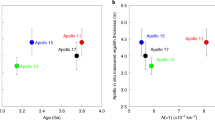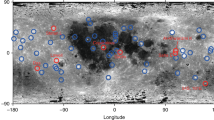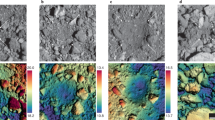Abstract
For several decades, most planetary researchers have regarded the impact crater populations on solid-surfaced planets and smaller bodies as predominantly reflecting the direct (‘primary’) impacts of asteroids and comets1. Estimates of the relative and absolute ages of geological units on these objects have been based on this assumption2. Here we present an analysis of the comparatively sparse crater population on Jupiter's icy moon Europa and suggest that this assumption is incorrect for small craters. We find that ‘secondaries’ (craters formed by material ejected from large primary impact craters) comprise about 95 per cent of the small craters (diameters less than 1 km) on Europa. We therefore conclude that large primary impacts into a solid surface (for example, ice or rock) produce far more secondaries than previously believed, implying that the small crater populations on the Moon, Mars and other large bodies must be dominated by secondaries. Moreover, our results indicate that there have been few small comets (less than 100 m diameter) passing through the jovian system in recent times, consistent with dynamical simulations3,4,5,6.
This is a preview of subscription content, access via your institution
Access options
Subscribe to this journal
Receive 51 print issues and online access
$199.00 per year
only $3.90 per issue
Buy this article
- Purchase on Springer Link
- Instant access to full article PDF
Prices may be subject to local taxes which are calculated during checkout


Similar content being viewed by others
References
Basaltic Volcanism Study Project. In Basaltic Volcanism on the Terrestrial Planets (eds Kaula, W. M. et al.) Ch. 8 (Pergamon, New York, 1981)
Shoemaker, E. M., Hackman, R. J. & Eggleton, R. E. Interplanetary correlation of geologic time. Adv. Astronaut. Sci. 8, 70–89 (1963)
Zahnle, K., Schenk, P. & Levison, H. Cratering rates in the outer Solar System. Icarus 163, 263–289 (2003)
Zahnle, K., Dones, L. & Levison, H. Cratering rates on the Galilean satellites. Icarus 136, 202–222 (1998)
Levison, H. F. et al. Planetary impact rates from ecliptic comets. Icarus 143, 415–420 (2000)
Levison, H. F. & Duncan, M. J. From the Kuiper Belt to Jupiter-family comets: the spatial distribution of ecliptic comets. Icarus 127, 13–32 (1997)
Shoemaker, E. M. Ballistics of the Copernican ray system. Proc. Lunar Planet. Colloq. 2, 7–21 (1960)
Neukum, G., Ivanov, B. A. & Hartmann, H. K. Cratering records in the inner solar system in relation to the lunar reference system. Space Sci. Rev. 96, 55–86 (2001)
Fielder, G. Ray elements and secondary-impact craters on the Moon. Astrophys. J. 135, 632–637 (1962)
Roberts, W. A. Secondary craters. Icarus 3, 348–364 (1964)
Kopal, Z. The nature of secondary craters photographed by Ranger VII. Icarus 5, 201–213 (1966)
Lucchitta, B. K. Crater clusters and light mantle at the Apollo 17 site—A result of secondary impacts from Tycho. Icarus 30, 80–96 (1977)
Shoemaker, E. M. Preliminary analysis of the fine structure of the lunar surface. In Ranger VII, Part II, Experimenters' Analyses and Interpretations 75–134 (Tech. Rep. No. 32–700, Jet Propulsion Laboratory, Pasadena, 1965)
Vickery, A. M. Variation in ejecta size with ejection velocity. Geophys. Res. Lett. 14, 726–729 (1987)
Vickery, A. M. Size-velocity distribution of large ejecta fragments. Icarus 67, 224–236 (1986)
Bierhaus, E. B., Chapman, C. R. & Merline, W. J. On the clustering of Europa's small craters. Lunar Planet. Sci. Conf. XXXII, abstr. no. 1967 (2001)
Bierhaus, E. B. Discovery that Secondary Craters Dominate Europa's Small Crater Population PhD thesis, Univ. Colorado at Boulder (2004)
Duda, R. O. & Hart, P. E. Pattern Classification and Scene Analysis (Wiley and Sons, New York, 1973)
Bierhaus, E. B., Chapman, C. R., Merline, W. J., Brooks, S. M. & Asphaug, E. Pwyll secondaries and other small craters on Europa. Icarus 153, 264–276 (2001)
Duncan, M., Levison, H. & Dones, L. in Comets II (eds Festou, M. C., Keller, H. U. & Weaver, H. A.) 193–204 (Univ. Arizona Press, Tucson, 2004)
Berstein, G. M. et al. The size distribution of trans-Neptunian bodies. Astron. J. 128, 1364–1390 (2004)
Schenk, P., Chapman, C. R., Zahnle, K. & Moore, J. M. in Jupiter (eds Bagenal, F., Dowling, T. E. & McKinnon, W. B.) 427–456 (Cambridge University Press, Cambridge, 2004)
Kato, M. et al. Ice-on-ice impact experiments. Icarus 113, 423–441 (1995)
Arakawa, M. et al. Ejection velocity of ice fragments. Icarus 118, 341–354 (1995)
Kato, M. et al. Shock pressure attenuation in water ice at a pressure below 1 GPa. J. Geophys. Res. 106, 17567–17578 (2001)
Ivanov, B. A., Neukum, G., Bottke, W. F. & Hartmann, W. K. in Asteroids III (eds Bottke, W. F., Cellino, A., Paolicchi, P. & Binzel, R. P.) 89–101 (Univ. Arizona Press, Tucson, 2002)
Hartmann, W. K. Martian cratering VI. Crater count isochrons and evidence for recent volcanism from Mars Global Surveyor. Meteorit. Planet. Sci. 34, 167–177 (1999)
Hauber, E. et al. Discovery of a flank caldera and very young glacial activity at Hecates Tholus, Mars. Nature 434, 356–361 (2005)
Murray, J. B. et al. Evidence from the Mars Express High Resolution Stereo Camera for a frozen sea close to Mars' equator. Nature 434, 353–356 (2005)
McEwen, A. S. et al. The rayed crater Zunil and interpretations of small impact craters on Mars. Icarus 176, 351–381 (2005)
Acknowledgements
E.B.B. was previously at the University of Colorado at Boulder and Southwest Research Institute, Boulder. NASA's Galileo and JSDAP programs funded the research reported here. We thank B. Ivanov for providing comments that improved the clarity and structure of this manuscript.
Author information
Authors and Affiliations
Corresponding author
Ethics declarations
Competing interests
Reprints and permissions information is available at npg.nature.com/reprintsandpermissions. The authors declare no competing financial interests.
Rights and permissions
About this article
Cite this article
Bierhaus, E., Chapman, C. & Merline, W. Secondary craters on Europa and implications for cratered surfaces. Nature 437, 1125–1127 (2005). https://doi.org/10.1038/nature04069
Received:
Accepted:
Issue Date:
DOI: https://doi.org/10.1038/nature04069
This article is cited by
-
Planned Geological Investigations of the Europa Clipper Mission
Space Science Reviews (2024)
-
Impact gardening on Europa and repercussions for possible biosignatures
Nature Astronomy (2021)
-
On the importance of self-secondaries
Geoscience Letters (2018)
Comments
By submitting a comment you agree to abide by our Terms and Community Guidelines. If you find something abusive or that does not comply with our terms or guidelines please flag it as inappropriate.



